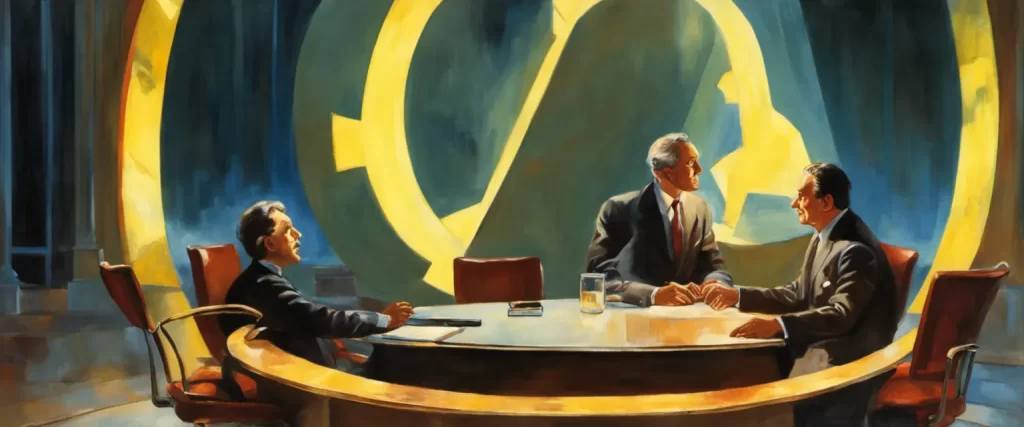——The Halo Effect by Phil Rosenzweig & Only The Paranoid Survive by Andrew Grove
In the realm of business literature, numerous authors have presented their theories and perspectives on achieving success, managing change, and understanding the inner workings of organizations. Two such remarkable contributions are Phil Rosenzweig’s “The Halo Effect” and Andrew Grove’s “Only The Paranoid Survive.” While both books aim to offer insights into the dynamics of business operations, they pursue different approaches in exploring these intricacies. This comparative study delves into the key concepts and divergent methodologies employed by Rosenzweig and Grove in order to decipher the underlying principles behind their work.
I. Background and Context:
To comprehend the significance of this comparative study, it is essential to understand the background and context in which “The Halo Effect” and “Only The Paranoid Survive” were written. Phil Rosenzweig, an esteemed professor and business strategist, penned his work in response to the often misleading findings and conclusions prevalent in management studies. Published in 2007, “The Halo Effect” critically examines the flawed methodologies and biases that plague various business theories by delving into the fallacy of attributing a company’s success or failure to a single factor.
Andrew Grove, on the other hand, was a distinguished executive and co-founder of Intel Corporation. In his 1996 book, “Only The Paranoid Survive,” Grove provides a first-hand account of Intel’s transformation from a memory chip producer to a global leader in microprocessors. Grove’s work emphasizes the necessity for organizations to be ever-vigilant and adaptive in an increasingly competitive landscape.
II. Objectives and Approach:
While “The Halo Effect” and “Only The Paranoid Survive” focus on different aspects of business management, both books strive to provide valuable insights and lessons for ensuring long-term success. Rosenzweig sets out to challenge popular management practices, calling for a more critical and nuanced approach to understanding organizational performance. In contrast, Grove’s book is centered around the imperative of strategic inflection points and the need to respond with urgency and adaptability to maintain market dominance.
This comparative study will first analyze the methodologies employed by Rosenzweig and Grove. We will explore Rosenzweig’s examination of flawed research techniques and biased interpretations, dissecting the impact of these pitfalls on the accuracy of management studies. Similarly, we will assess the real-life experiences and anecdotes presented by Grove, discerning the practicality and effectiveness of his strategies for navigating volatile business landscapes.
Furthermore, the study will delve into the central themes and arguments put forth in each book. Examining the depth of research, case studies, and supporting evidence provided by Rosenzweig, we will evaluate the strength of his critique on the Halo Effect and its implications for management practitioners. Alongside, we will explore Grove’s perspective on recognizing strategic inflection points, analyzing the practicality and relevance of his proposed survival strategies.
III. Significance and Scope of the Comparative Study:
The significance of this comparative study lies in its potential to shed light on how management theories and strategies can transform and evolve over time. By comprehensively analyzing “The Halo Effect” and “Only The Paranoid Survive,” readers can gain a deeper understanding of the factors influencing organizational performance and the approaches required to maintain long-term success.
Moreover, this study will further contribute to the existing body of knowledge within the field of management studies. By critically examining the methodologies, arguments, and insights presented by Rosenzweig and Grove, it will allow for an evaluation of their validity and practicality in real-world scenarios.
In the following sections of this comparative study, we will delve into the distinctive features of each book, their methodologies, central arguments, and the implications they hold for management practices in contemporary business environments. Through this journey, we will aim to uncover valuable lessons and principles that can guide aspiring leaders and professionals in their pursuit of success.
Brief Summary of Two Books
The Halo Effect by Phil Rosenzweig
“The Halo Effect” by Phil Rosenzweig challenges the popular and flawed business practices of seeking out “excellent” companies and studying them as models for success. The book argues that the widespread tendency to attribute a wide range of positive qualities to successful companies, known as the halo effect, is a misleading approach when trying to understand what truly drives success or failure.
Rosenzweig examines numerous case studies and academic research, highlighting how market performance and strategic decisions are influenced by multiple factors, including luck, timing, and industry dynamics. He argues against relying solely on post hoc analysis and cherry-picking successful companies as models. Instead, Rosenzweig emphasizes the importance of understanding the context and complexity surrounding business outcomes.
The book delves into the dangers of cognitive biases and the allure of simplistic management approaches that focus on emulating successful companies. Additionally, Rosenzweig explores the impact of “left out” companies, those that have experienced failures or underperformance, and their valuable lessons often ignored due to the halo effect.
Overall, “The Halo Effect” provides a critical examination of the flawed thinking prevalent in the business world and advocates for a more nuanced and comprehensive approach to understanding business success and failure.
Only The Paranoid Survive by Andrew Grove
“Only The Paranoid Survive” is a book written by Andrew Grove, who was the co-founder and former CEO of Intel Corporation. In this book, Grove shares his insights and experiences in the fast-paced and constantly changing world of business.
The central idea of the book is that in order to succeed in business, individuals and organizations must be willing to change and adapt, even if it means abandoning their existing strategies and practices. Grove refers to this mindset as being “paranoid,” suggesting that businesses must always be vigilant and proactive in the face of potential disruptions or threats.
Grove discusses the various stages of a company’s life cycle and highlights the importance of recognizing the signs of an impending crisis or situation that requires drastic action. He emphasizes the need for leaders to be willing to confront reality, make tough decisions, and act swiftly to steer their organizations in the right direction.
The author also shares personal anecdotes and case studies from his time at Intel, illustrating how the company successfully navigated through difficult times and transformed itself to stay relevant in the highly competitive semiconductor industry.
Overall, “Only The Paranoid Survive” serves as a call to action for business professionals, urging them to embrace a mindset of constant vigilance and adaptability in order to thrive in today’s rapidly changing business landscape.
Comparison between Two Books

Similarities in Business Strategy
Both The Halo Effect by Phil Rosenzweig and Only The Paranoid Survive by Andrew Grove discuss various aspects of business strategy and share a few similarities:
1. Focus on Objective Analysis: Both books emphasize the importance of objective analysis in business strategy. They argue that decision-making should be based on facts and data rather than subjective opinions or biases. Rosenzweig emphasizes the need to distinguish between causality and correlation, while Grove emphasizes the importance of constantly monitoring and analyzing industry dynamics.
2. Skepticism towards Success Stories: Both authors caution against blindly following success stories, as they argue that survivorship bias often distorts the lessons learned. They highlight the importance of critically examining both successful and unsuccessful companies to identify underlying causes of success or failure. Rosenzweig advises against falling for the “Halo Effect,” which attributes success to a company’s overall greatness rather than specific actions.
3. Adaptation and Agility: Both books stress the need for businesses to adapt and be agile in response to changing market dynamics. Rosenzweig highlights the risk of complacency and warns against a single-minded focus on one golden rule of business. Grove discusses the concept of strategic inflection points, where companies must be willing to adjust their strategies drastically to stay competitive.
4. Emphasis on Competitive Advantage: Both authors recognize the importance of establishing and maintaining a competitive advantage in business strategy. Rosenzweig argues that identifying and cultivating specific capabilities or resources can provide sustainable competitive advantages. Grove emphasizes the need for constantly reassessing and adjusting business models and strategies to maintain competitive advantage in an evolving market.
5. Learning from Failures: Both books encourage learning from failures as a crucial element of business strategy. Rosenzweig argues that analyzing and understanding failures can provide valuable insights into improving future decisions, rather than simply attributing them to bad luck. Grove also emphasizes the importance of embracing a constructive paranoia mindset, where failures and potential threats are analyzed and understood to drive continuous improvement.
6. Recognition of Uncertainty: Both authors acknowledge the uncertainty inherent in business strategy and decision-making. They caution against overreliance on planning and forecasting, emphasizing the need to remain flexible and responsive to unexpected events or changes. Rosenzweig argues that probabilistic thinking is essential in decision-making, while Grove discusses the need for a strategic mindset that anticipates and prepares for various scenarios.
Overall, The Halo Effect and Only The Paranoid Survive approach business strategy from different perspectives but share common themes such as objective analysis, adaptability, competitive advantage, and learning from failures. They both highlight the need for businesses to critically evaluate their strategies and avoid cognitive biases, while also acknowledging the dynamic and uncertain nature of the business environment.
Divergences in Business Strategy
The Halo Effect by Phil Rosenzweig and Only The Paranoid Survive by Andrew Grove are both highly regarded books on business strategy. However, they provide different perspectives and offer diverging insights into the world of business strategy.
1. Focus on Internal vs. External Factors: The Halo Effect delves into the traps of management literature and the tendency to attribute a company’s success or failure to specific internal factors. Rosenzweig argues that many business books oversimplify complex situations and fail to consider the external factors that may have contributed to success or failure. On the other hand, Only The Paranoid Survive by Andrew Grove concentrates on the importance of internal factors, such as adapting to changes and making critical decisions to survive in a highly competitive market.
2. The Role of Strategy: In The Halo Effect, Rosenzweig challenges the idea that successful companies implement a specific strategy that led to their success. He argues that strategies are often developed in hindsight, and it is more important to focus on the execution of those strategies rather than searching for the “magic bullet” strategy. Conversely, Grove’s Only The Paranoid Survive emphasizes the need for proactive strategies in response to rapidly changing markets. He emphasizes that businesses should strive to “anticipate the moves of rivals, charting a course for the future.”
3. Relation of Performance and Strategy: Rosenzweig discusses in The Halo Effect how a company’s performance and strategy are interrelated, arguing against the common belief that successful companies have unique strategies, while failing companies do not. He highlights that it is the overall execution of strategies, adaptability, and external factors that play a significant role in a company’s success. In contrast, Grove’s Only The Paranoid Survive suggests that companies must assess their own performance and make strategic decisions accordingly, based on their position in the market and the threats they face.
4. Learning from Failure: The Halo Effect argues that analyzing failed companies solely to identify their mistakes and avoid them is insufficient, as external factors and chance play a significant role in business outcomes. Rosenzweig believes that studying successful companies is equally important to understand their overall context and complexity. In Only The Paranoid Survive, Grove emphasizes the importance of learning from failure and using it as a catalyst for change and improvement. He shares personal experiences of Intel’s transformation to highlight the significance of acknowledging failures and taking appropriate action.
While both books contribute valuable insights into business strategy, their differing perspectives on the factors influencing success or failure and the role of strategy in adapting to market changes create divergence in their overall approach. The Halo Effect focuses on the limitations of attributing success or failure to specific internal factors, while Only The Paranoid Survive emphasizes the importance of internal strategies and adaptability to navigate business challenges successfully.

Conclusion
Both “The Halo Effect” by Phil Rosenzweig and “Only The Paranoid Survive” by Andrew Grove are highly regarded books in the field of management. However, the worthiness of reading these books can depend on your personal interests and what you are looking to gain from the reading.
“The Halo Effect” by Phil Rosenzweig aims to debunk some prevalent management myths and challenges the popular belief that successful companies have a set of universally applicable attributes that contribute to their success. Instead, Rosenzweig argues that success is often a result of multiple factors and it is important to analyze individual cases and situations in order to understand the reasons behind success or failure. If you are interested in a critical analysis of management concepts and debunking of popular myths, this book might be more suitable for you.
On the other hand, “Only The Paranoid Survive” by Andrew Grove focuses on strategic management in times of crisis. Grove, former CEO of Intel, shares his experiences and strategies for companies to adapt and survive during turbulent times. If you are looking for insights and practical advice on strategic decision-making and crisis management, this book could be more appealing to you.
Ultimately, the worthiness of reading these books depends on your individual preferences and what you are looking to gain from the reading experience. Consider your interests and what you hope to learn, and choose the book that aligns with your goals.



